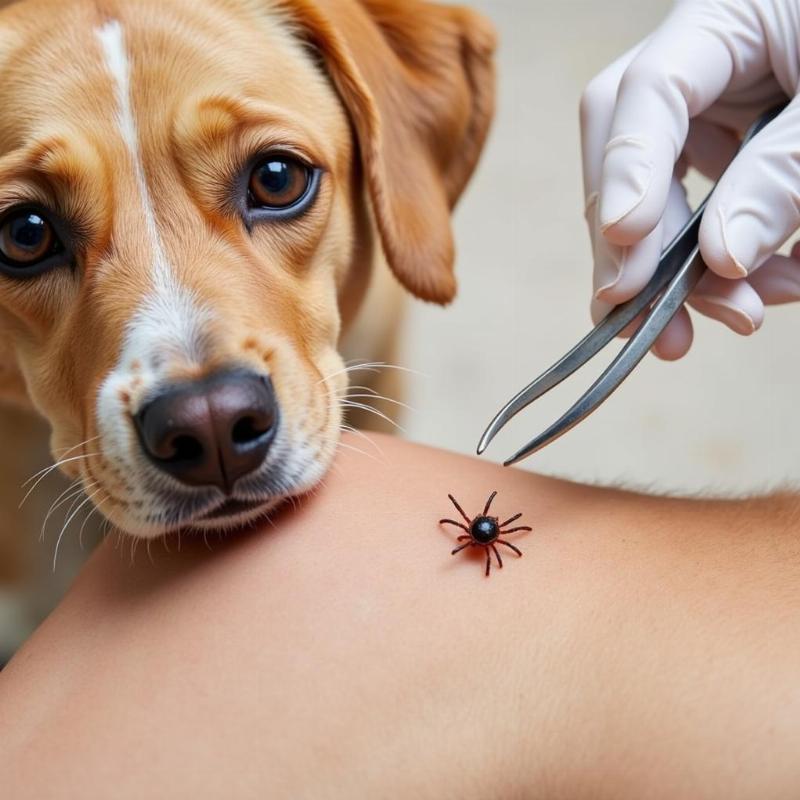Ticks are a common concern for dog owners across the US, and understanding how they interact with a dog’s skin is crucial for effective prevention and removal. The question “can ticks burrow into dogs skin?” is frequently asked, and the answer requires some clarification. While ticks don’t entirely burrow their whole bodies under the skin like some parasites, they do embed their mouthparts to feed. This can create the appearance of burrowing, leading to confusion and anxiety for pet owners.
Understanding Tick Attachment
Ticks don’t have the anatomical tools to burrow completely under the skin like a mange mite. Instead, they use their specialized mouthparts, which include barbed hypostomes, to latch onto your dog’s skin and feed on their blood. This process involves inserting the hypostome into the skin, creating a firm anchor. This is what often gives the impression that the tick has burrowed itself. The longer a tick remains attached, the more deeply embedded its mouthparts become, making removal more challenging and potentially increasing the risk of disease transmission.
Why Prompt Tick Removal is Vital
Since ticks transmit diseases like Lyme disease, Rocky Mountain spotted fever, and ehrlichiosis, prompt removal is paramount. The Centers for Disease Control and Prevention (CDC) recommends removing ticks as soon as possible to minimize the risk of infection. The sooner you remove the tick, the less time it has to transmit pathogens to your dog.
How to Properly Remove a Tick From Your Dog
Using fine-tipped tweezers, grasp the tick as close to your dog’s skin as possible. Pull upward with steady, even pressure. Avoid twisting or jerking, as this can break off the mouthparts and leave them embedded in the skin. After removal, clean the area with antiseptic and monitor the site for any signs of infection, such as increased redness, swelling, or discharge. Consult your veterinarian if you have any concerns.
 Removing a Tick with Tweezers
Removing a Tick with Tweezers
Preventing Tick Infestations
Preventing tick infestations is the best way to protect your dog from tick-borne diseases. Several effective preventative measures are available in the US market, including topical treatments, oral medications, and tick collars. Talk to your veterinarian about the best option for your dog, considering their lifestyle, breed, and health. Regularly checking your dog for ticks, especially after spending time outdoors in grassy or wooded areas, is also crucial. Keeping your lawn mowed short and removing leaf litter can also help reduce tick populations in your yard.
When to Contact Your Veterinarian
If you’re unsure how to remove a tick, or if you notice any signs of infection at the bite site, contact your veterinarian immediately. They can safely remove the tick and advise on appropriate treatment if needed. Additionally, if your dog develops any symptoms like fever, lethargy, loss of appetite, or joint pain after a tick bite, consult your veterinarian for testing and diagnosis.
Conclusion
While ticks don’t technically burrow into a dog’s skin, their feeding process can create that impression. Understanding how ticks attach and the importance of prompt removal is key to protecting your furry friend from tick-borne illnesses. Regular preventative measures and vigilant monitoring are the best ways to keep your dog safe and tick-free.
FAQ
- What are the most common tick-borne diseases in dogs in the US? Lyme disease, Rocky Mountain spotted fever, ehrlichiosis, and anaplasmosis are some of the most common tick-borne diseases affecting dogs in the US.
- How long does it take for a tick to transmit a disease? The time it takes for a tick to transmit a disease varies depending on the pathogen. For some diseases, transmission can occur within hours, while others may take 24-48 hours or longer.
- Can I use human tick removal methods on my dog? While some methods might be similar, always consult your veterinarian for guidance on the safest and most effective way to remove ticks from your dog.
- Are there any home remedies for tick removal? Avoid home remedies like petroleum jelly or burning the tick, as these methods can be ineffective and potentially harmful to your dog. Stick to proven methods like using tweezers.
- How often should I check my dog for ticks? Check your dog daily, especially during tick season, and after they’ve been in areas where ticks are likely to be present, such as tall grass or woods.
- Are there any vaccines for tick-borne diseases in dogs? Vaccines are available for Lyme disease and some other tick-borne diseases. Talk to your veterinarian about whether vaccination is appropriate for your dog.
- What should I do with the tick after I remove it? Place the removed tick in a sealed bag or container filled with rubbing alcohol to kill it. This can be helpful for identification if your dog develops symptoms later.
Beautdogs.us is your trusted source for comprehensive and engaging information on dog care, breeds, and products specifically tailored for the US market. Whether you’re a seasoned dog owner or just starting your journey, Beautdogs.us offers expert advice, breed-specific insights, and access to top-quality products and services. Connect with us today for expert guidance on all things dog-related! Email: [email protected], Phone: +1 501-555-7529 or visit us at Beautdogs.us.